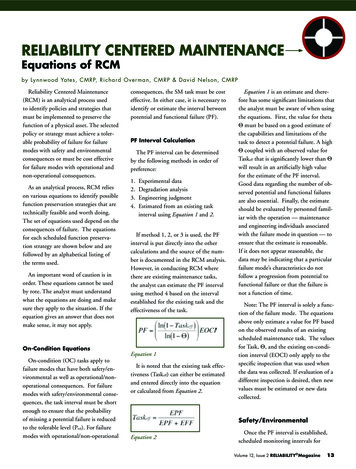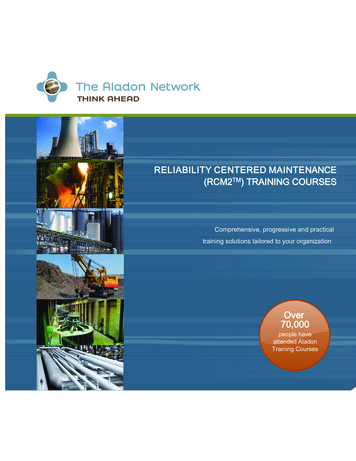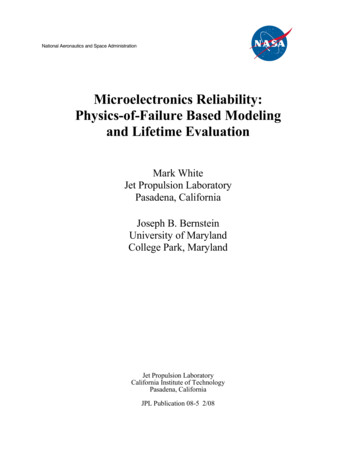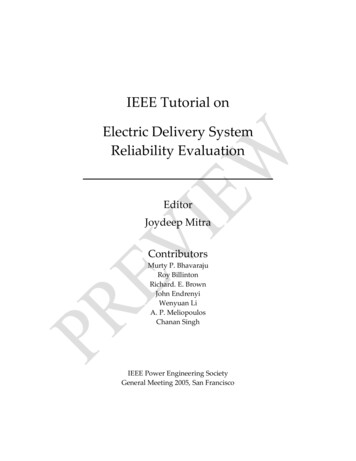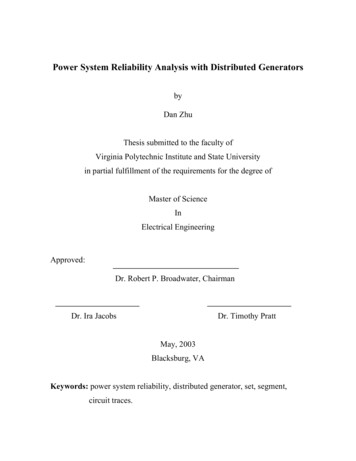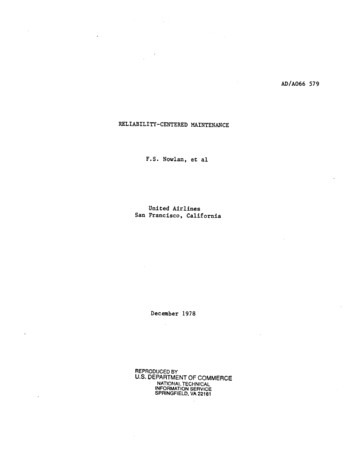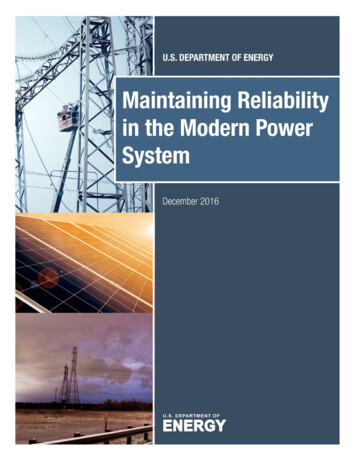
Transcription
REVIEW
ACKNOWLEDGEMENTSThis report was produced by the U.S. Department of Energy’s Office of Energy Policy and Systems Analysis (DOEEPSA) under the direction of Aaron Bergman with substantial input from Paul Denholm and Daniel C. Steinberg ofthe National Renewable Energy Laboratory and David Rosner of the Department of Energy. We would like to thankthe peer reviewers inside and outside of government who provided helpful comments on the document. Figure 2is adapted with permission from Mills and Wiser 2012. Figures 7 and 9 are used with permission from MarkO’Malley, University College Dublin.This report was prepared as an account of work completed by an agency of the United States Government. Neitherthe United States Government nor any agency thereof, nor any of their employees, makes any warranty, expressor implied, or assumes any legal liability or responsibility for the accuracy, completeness, or usefulness of anyinformation, apparatus, product, or process disclosed, or represents any specific commercial product, process, orservice by trade name, trademark, manufacture, or otherwise does not necessarily constitute or imply itsendorsement, recommendation, or favoring by the United States Government or any agency thereof. The viewsand opinions of authors expressed herein do not necessarily state or reflect those of the United StatesGovernment or any agency thereof.i
TABLE OF CONTENTSAcknowledgements . iExecutive Summary . 1Introduction. 4Following the Four Rules: Past, Present, and Future . 6Rule 1: Power Generation and Transmission Capacity Must Be Sufficient to Meet Peak Demand forElectricity. . 6Why Peak Demand Matters . 6Complying with Rule 1: Traditional Means. 8Complying with Rule 1: New Options . 10Rule 2: Power systems must have adequate flexibility to address variability and uncertainty indemand (load) and generation resources. . 16Why Flexibility Matters . 16Complying with Rule 2: Traditional Means. 17Complying with Rule 2: New Options . 17Rule 3: Power Systems Must be able to Maintain Steady Frequency . 20Why Steady Frequency Matters . 20Complying with Rule 3: Traditional Means. 23Complying with Rule 3: New Options . 24Rule 4: Power Systems Must Be Able to Maintain Steady Voltage at Various Points on the Grid . 28Why Voltage Stability Matters. 28Complying with Rule 4: Traditional Means. 29Complying with Rule 4: New Options . 30Conclusion . 31References . 32List of FiguresFigure 1. Historic hourly load patterns for ERCOT, CAISO, NYISO and Florida Power and Light for importantweeks in 2014. 6Figure 2. Capacity credit of PV as a function of penetration for different regions. 11Figure 3. Load and net load profiles for California under increased penetration of PV for threerepresentative days of peak demand in the summer . 12Figure 4. Example of identical energy use with different consumption patterns during a 24-hour period . 13Figure 5. Increased PV penetration leads to shorter intervals of peak demand . 15Figure 6. Increase in net load variability with added wind . 16Figure 7. Representation of the existing grid powered by synchronous generators . 20Figure 8. Sequence of reserves activation in response to a contingency event such as a large power plantfailure . 21ii
Figure 9. Representation of a grid with both synchronous and inverter-based generators . 24Figure 10. Power systems maintain voltage at different levels in different parts of the power system . 28List of TablesTable 1. Regulating and Spinning Contingency Reserve Requirements in U.S. Wholesale Markets . 23Table 2. Additional Regulating Reserve Requirements Due to the Addition of VG . 25iii
EXECUTIVE SUMMARYThe electric sector is undergoing a time of transition. Inexpensive natural gas, lower cost renewablepower and increased use of energy efficiency and distributed generation are leading to a transformationin the way power is produced and delivered to consumers. As a consequence, many of the oldparadigms that govern the sector are also evolving, importantly the traditional model of largecentralized generators as a means of producing electricity and maintaining reliability. As more of thesegenerators have retired in recent years and been replaced with new sources of power and energyefficiency, there have been questions about how to sustain the current level of reliability. This paperdiscusses the tools that the power sector will use to maintain reliability through this time oftransformation.While there are numerous standards and regulations that govern reliability of the power sector, thispaper consolidates them into four “rules”:1. Power generation and transmission capacity must be sufficient to meet peak demand forelectricity2. Power systems must have adequate flexibility to address variability and uncertainty in demand(load) and generation resources3. Power systems must be able to maintain steady frequency4. Power systems must be able to maintain voltage within an acceptable rangeFor each rule, we discuss how it has been met historically and the new technologies and practices thatwill let it be met during and after this time of power sector transformation. The conclusion is that, whilereliability has been historically maintained by a limited set of tools, primarily large spinning generators,there is now a new toolbox for maintaining reliability. With this new toolbox and continued carefulplanning, coordination and investment, reliability can remain a trademark characteristic of our evolvingpower system.POWER GENERATION AND TRANSMISSION CAPACITY MUST BESUFFICIENT TO MEET PEAK DEMAND FOR ELECTRICITYThe power grid must have sufficient capacity available to meet the demand for electricity. Because thereare uncertainties in forecasting demand and the potential for generation and transmission outages, thetotal amount of capacity is required to exceed the expected level of demand by a given fraction, termedthe reserve margin, often about 15%.TRADITIONAL MEANS : Large conventional generators have traditionally provided the capacity tomeet peak demand and reserve margins, and high voltage transmission lines have provided the meansto move the power to where it is needed. In recent years, resources that lower demand for electricityhave also begun to play a significant role.1
NEW OPTIONS : While one cannot know far in advance the output of any variable resource such aswind and solar, these resources can still play a role in meeting peak demand by taking into account theprobabilistic aspects of their generation profile. Aggregation of these resources can reduce their overallvariability. Demand response and smart grid technologies can be used to reduce peak load. Lastly,storage can be used to meet peak load by saving power (or thermal energy) from when it is cheaper togenerate and using it when it is most valuable.POWER SYSTEMS MUST HAVE ADEQUATE FLEXIBILITY TO ADDRESSVARIABILITY AND UNCERTAINTY IN DEMAND (LOAD) AND GENERATIONRESOURCESThe level of demand changes throughout the day and from season to season. This, and the addition ofvariable generation such as wind and solar, places a premium on having flexible generation capacity thatcan change its level of output to account for changes in demand and the amount of generation fromvariable resources (such as when the wind stops blowing or the sun goes down).TRADITIONAL MEANS : Traditionally, the need for flexible generation has been met with natural gasgenerators, which are capable of ramping their output up and down rapidly. Demand response has alsoplayed a growing role. Recent analyses indicate that the current level of flexibility on the grid canaccommodate variable generation levels of up to 35% of all generation.NEW OPTIONS : Many grid operators are planning to or are already implementing policies to increasethe flexibility of their systems. New, modern gas generators have been designed to provide very fastramp rates. Expanded use of demand response also provides more flexibility. Lastly, it is possible to addtechnology to allow variable resources to decrease generation and, potentially, to increase it if they arenot using all available power. This ability to dispatch variable generation is already being used to provideflexibility across the country.POWER SYSTEMS MUST BE ABLE TO MAINTAIN STEADY FREQUENCYThe power system uses what is called alternating current (AC) where the electricity reverses directionsixty times per second (60 Hz). If this frequency of oscillation were to deviate significantly from 60 Hz, itcould damage machines and electronics. Any mismatch between the supply and demand of electricitycan cause this sort of deviation, and a number of mechanisms operating at different timescales are usedto maintain a steady frequency.TRADITIONAL MEANS : Large spinning generators are used to arrest any change in frequencybecause it takes time for them to change their rate of rotation. Generators can have governors thatdetect any change in their rate of rotation and increase or decrease power to compensate. On longertimescales, generation that can rapidly respond is kept in reserve to match supply and demand.2
NEW OPTIONS : Studies have shown that increased levels of variable generation on the grid increasereserve requirements necessary to maintain a steady frequency, but these increases are quite modest.Transmission can be used to average out some of the variability and reduce the need for additionalreserves. Even as they retire, large spinning generators can be used as “synchronous condensers” thatspin synchronously with the grid, not consuming fuel, but serving to arrest changes in frequency. Inaddition, it is possible to make a variable resource act like a large spinning generator through the use ofadvanced power electronics. Demand response and storage to balance supply and demand also willlikely play a growing role in maintaining a steady frequency.POWER SYSTEMS MUST BE ABLE TO MAINTAIN VOLTAGE WITHIN ANACCEPTABLE RANGEIn addition to maintaining a steady frequency, the electric grid must also deliver electricity at a givenvoltage. This voltage varies throughout the power grid with transformers used to change voltages.Maintaining the correct voltage requires the management of “reactive power” which is a property of ACelectricity that allows power to flow. If the levels of reactive power are too high or are too low, thevoltage level can change, potentially even collapsing catastrophically.TRADITIONAL MEANS : Large spinning generators that are synchronized with the grid can controlvoltage levels and reactive power by adjusting their output. Various electrical devices such as shuntcapacitors are used to control reactive power throughout the transmission and distribution networks.NEW OPTIONS : As with frequency control, advanced power electronics can give variable generationresources like wind and solar the ability to control reactive power and voltage. FERC has recently issuedan order requiring this capability on larger variable generation units. Many types of storage can also usethis sort of power electronics. In addition, synchronous condensers can be used to provide reactivepower. Lastly, there is a class of relative inexpensive electronic devices called Flexible AC TransmissionSystems (FACTS) that have existed for a while but are becoming less expensive and more widelydeployed and can solve many voltage control problems that historically would have required larger andmore costly generators, transmission lines or electromechanical devices.3
INTRODUCTIONIn the United States, we enjoy the benefits of a highly reliable electrical power system. Reliable,affordable electric power fuels the economy and supports our quality of life. Each time we turn on alight, plug in a phone, approach a traffic signal, or log onto a computer, we trust that the power systemwill be working to enable the services we expect. That is power system reliability: the ability of thesystem to deliver expected service through both planned and unplanned events.Catastrophic events such as hurricanes and earthquakes can disrupt U.S. power service, but day-to-dayinterruptions are rare. Typically, power system failures result in interruption in customer service for lessthan 3 hours of the 8,760 hours in a year.1 Furthermore, most of these failures affect relatively fewcustomers and occur on the distribution system—the network of local lower-voltage power lines thattransfer electricity from the high-voltage bulk power system to our homes and businesses. Poweroutages due to failures of the bulk power transmission system are far less common. This is due, in largepart, to how such power systems are built and operated so that safeguards keep the systems runningeven when any individual component fails.The high level of reliability provided by the U.S. grid is not by accident.2 The U.S. Department of Energy,Federal Energy Regulatory Commission (FERC), North American Electric Reliability Corporation (NERC),regional planning authorities, utilities, power system operators, and other organizations work to ensureadequate reliability of the U.S. power system through implementation of reliability standards, timelyplanning and investment, and effective system operations and coordination.During most of the 20th century, electric utilities adhered to industry and self-imposed reliability criteriafor electricity generation and transmission as they built and operated large hydroelectric, nuclear, andfossil-fueled power plants. These power plants, regionally connected with high-voltage power lines, nowform the foundation of reliable, affordable electricity systems throughout the United States andinternationally.Recently, however, a combination of market forces and emerging trends are transforming the ways wegenerate and deliver electricity. Key drivers include comparatively low-cost natural gas, the increase indeployment of renewable energy technologies, environmental policies, consumer preferences, lowdemand growth, and the creation and continued evolution of restructured electricity markets. In manycases, the traditional model of large centralized generators is evolving as retiring generators arereplaced with variable wind and solar generators, smaller and more flexible natural gas generators, andnon-traditional resources such as demand-response (DR) and distributed generation. In the midst of1This is the national average. There is a very large variation by state. In 2013, the range was 7 minutes on averagein Vermont to more than 18 hours in South Dakota. See Wirfs-Brock, J. 2015. “How Long is Your Blackout?” InsideEnergy. Accessed March 2016, w-long-is-your-blackout/2For additional discussion of the concept of power system reliability s/Adequate Level of Reliability Definition (InformationalFiling).pdf.4
these changes, a variety of new technologies and practices have arisen to help maintain electric systemreliability. In this paper, we examine how power system operators are using these new technologies andpractices to maintain a high level of grid reliability.There is an extensive set of standards and regulations that utilities and system operators must meet tomaintain a reliable grid. For this report, we consolidate these into four overarching “rules”3 for powersystem reliability:1. Power generation and transmission capacity must be sufficient to meet peak demand forelectricity2. Power systems must have adequate flexibility to address variability and uncertainty in demand(load) and generation resources3. Power systems must be able to maintain steady frequency4. Power systems must be able to maintain voltage within an acceptable rangeIn the remainder of this paper, we will discuss each of these rules, how they have been met historicallyand how modern energy system practices and technologies—including variable renewable generationlike wind and solar power and “smart grid” technologies—give power system operators new tools andmethods for ensuring power system reliability.3These “rules” are not directly formalized in any single regulation. Instead, they represent a summary of thenumerous regulations and practices that grid operators follow to maintain reliability.5
FOLLOWING THE FOUR RULES: PAST,PRESENT, AND FUTURERULE 1: POWER GENERATION AND TRANSMISSION CAPACITY MUST BESUFFICIENT TO MEET PEAK DEMAND FOR ELECTRICITY.WHY PEAK DEMAND MATTERSThe demand for electricity varies over short and long timescales. Typically, electricity demand is higherduring the day and during warmer summer months, which aligns with greatest use of air conditioning.The demand for electricity on a hot summer afternoon can be more than twice the demand duringspring evenings. This pattern of demand is similar across most of the United States, although somenorthern states experience peak demand during winter. Figure 1 illustrates the hourly demand for threedifferent one-week periods in four regions of the country. The power system must be able to effectivelydeliver energy during these peak demand periods, or there would partial black-outs. Having sufficientresources available on the system to be able to meet peak demand is called “resource adequacy”.Figure 1. Historic hourly load patterns for ERCOT (Texas), CAISO (California), NYISO (New York)and Florida Power and Light for significant weeks in 2014.6
System planners estimate the total peak demand for electricity for several years into the future toaccount for expected load growth. This process is called “load forecasting.” Planners then determine ifor how much additional capacity will be needed to meet forecast demand. These calculations typicallyaccount for existing capacity, anticipated plant retirements and a host of federal and state regulatoryissues ranging from emissions regulations to renewable portfolio standards. In some cases, retiredgenerators are not replaced at all, which removes some capacity from the power system. There is somedegree of regional variation in the methods that planners use to calculate the amount of capacityrequired to meet peak load, but all planners must develop an estimate of the required capacity.Forecasting and advance planning help ensure that utilities and developers have adequate lead time tobring new generators and supporting infrastructure online, as the approval, permitting and constructionprocess can take several years.Two key steps are important when determining the total generation capacity requirement: 1) establish atarget resource adequacy level (often measured by loss of load expectation as discussed later in thissection), and 2) estimate the amount of generation needed to meet that resource adequacy level (oftenmeasured by the planning reserve margin). These steps are repeated (typically at least once a year) toensure that the system is able to respond to load growth and other factors affecting system reliability.The planning reserve margin is the quantity of “spare” or “backup” capacity that the utility or gridoperator holds in reserve that can be used to respond to a range of factors that could threaten theability to meet load. These factors include:1. Errors in forecasting: Load can be higher than anticipated, as is the case when unusually hotsummer weather creates a spike in air conditioning demand.2. Forced (unplanned) outages: No power plant is 100% reliable, and since generators can fail, it isnecessary to have spare capacity available to provide backup.3. Transmission outages: Transmission lines and associated equipment can also fail, which limitsthe amount of electricity that can be delivered from generators to load.The planning reserve margin is measured by the total amount of capacity available (typically measuredin MW) above the expected peak demand. For example, a system with an anticipated peak demand of10,000 MW might maintain a planning reserve margin of 15%, or a total of 11,500 MW of conventionalcapacity. The 1,500 MW of “spare” capacity is then available to maintain system reliability. In setting theplanning reserve margin target, utilities, system operators or regulators often rely on detailed reliabilitycalculations to determine how much capacity is needed to ensure that blackouts rarely occur. Forexample, a utility may set a planning reserve margin based on a loss-of-load expectation target of 0.1days/year or 0.1 events/year.4 Once the target planning reserve margin is set and the total amount of4For a comprehensive discussion, see Pfeifenberger et al. (2013), who note, “Although the 1-in-10 standard iswidely used across North America, substantial variations in how it is implemented mean that it does not representa uniform level of reliability . the 1-in-10 standard may be interpreted as either one event in ten years or one dayin ten years. One event in ten years translates to 0.1 loss of load events (LOLE) per year, regardless of themagnitude or duration of the anticipated individual involuntary load shed events. One day in ten years translatesto 2.4 loss of load hours (LOLH) per year, regardless of the magnitude or number of such outages.”7
capacity needed is estimated, utilities or project developers determine what type of resources to buildto provide that capacity.COMPLYING WITH RULE 1: TRADITIONAL MEANSTraditionally, system operators rely on generators to provide the capacity to meet planning reservemargins. However, building adequate conventional capacity is not the only tool for maintaining resourceadequacy. Energy Efficiency (EE) and Demand Response (DR) have been used by utilities to reduce peakdemand. By lowering peak demand, these options can often act as a direct substitution for conventionalcapacity for meeting planning reserve margins and maintaining system reliability. In addition, theconstruction of new transmission lines to enable access to power from neighboring resources has alsobeen used as a traditional means of meeting reserve margins.CONVENTIONAL POWER PLANTSBefore the large-scale penetration of variable generation (VG) resources, power plants were oftencategorized by the type of load they commonly provided: baseload, intermediate or peaking. Generally,different types of plants are used to meet each type of load. Baseload plants, which are typically lowercost nuclear or coal plants, are used to meet the constant demand on the system. Although the outputlevels of these plants can be altered, it is usually most economical for them to run at close-to-fullcapacity at all times. Intermediate load plants, often gas-fired, including combined-cycle plants, are usedto meet the daily variations in demand. More recently, low gas prices are prompting the use of naturalgas combined-cycle (NGCC) plants as baseload plants. Where available, hydroelectric units are also usedas baseload or intermediate load plants. Finally, peaking generators meet the more extreme spikes indemand and often are used for only a few hours of the year. Peaking generators are typically “simplecycle” gas turbines or older gas- or oil-fired steam generators.5 Peaking plants are relatively inexpensiveto build but are more expensive to run because they are generally less efficient than other types ofplants or use more expensive fuel. In planning and daily operations, system operators tend to choosethe mix of generators that allows them to meet demand in the most economic fashion. Determining thismix is an important part of planning the power system.The emergence of wholesale energy and capacity markets has led some of the planning to be replacedby market mechanisms, but developers still examine patterns of load growth, system requirements, andexpected utilization to determine the type of plant to construct.ENERGY EFFICIENCYEnergy efficiency improvements reduce the amount of electricity required to provide a particular enduse service, such as lighting or air-conditioning. For example, more efficient devices such as lightemitting diode (LED) light bulbs provide the same amount of light (lumens) as traditional incandescentbulbs, but use a fraction of the energy. Reducing end-use consumption of electricity through energyefficiency improvements can displace the need for new capacity. For example, because most of the5In some locations, peak demand is met with pumped storage plants, which store energy by pumping water up ahill to a reservoir and then release that stored energy through a conventional hydroelectric generator duringperiods of peak demand.8
United States has peak demand in the summer, more efficient air conditioning can maintain comfortlevels with less power, and more efficient lighting that loses less energy to heat would, in turn, makebuildings easier to cool and lower demand on air conditioning systems.DEMAND RESPONSE AND INTERRUPTIBLE LOADDR and interruptible load are additional tools that can be used to reduce the need for capacity withoutimpacting levels of service. Instead of building new capacity, utilities can provide incentives to (or pay)electricity users to reduce demand (often referred to as conservation) or to shift demand to parts of theday with lower demand (often referred to as load-shifting), thus reducing the overall need for capacity.Such programs can be cost-effective as long as the cost of incentive payments is less than the cost ofnew generation capacity.Historically, large industrial and commercial customers have been offered “demand-based” or“interruptible” rates.6 Under demand-based plans, utilities charge customers a higher rate for usageduring peak demand periods. This provides incentives for large industrial consumers to reduce demandduring these periods, which in turn reduces the need for peaking capacity. Under interruptible ratestructures, in exchange for offering lower electric rates, the utility reserves the option to limit or turn offelectricity supply to the customer under certain defined circumstances. These rates structures are veryrare for smaller consumers such as households because of the need for (historically) expensivecommunications and metering equipment. However, that is changing, as discussed below under “SmartGrid Technologies.”Utilities also offer DR programs for residential customers. A common type is direct load control (DLC)programs. DLC programs allow utilities to directly control certain appliances—most frequently airconditioners and electric water heaters—to reduce peak demand.7 In exchange for a reduction on thecustomer’s bill, the utility installs a remotely controlled switch on the appliance and receives the right tooccasionally turn off the appliances for short intervals, often 15 - 30 minutes.8 For most consumers theinterruption of service is rarely noticeable.9 More recently, new classes of demand-response programsare available through the emergence of wholesale markets; see “Smart Grid Technologies” belo
In addition to maintaining a steady frequency, the electric grid must also deliver electricity at a given voltage. This voltage varies throughout the power grid with transformers used to change voltages. Maintaining the correct voltage requires the management of “reactive power” which is a property of A

